Found a total of 10000 related content

What is the purpose of the and elements?
Article Introduction:The s and tags in HTML are used to create content areas that are hidden by default and expanded after clicking; 1. It is a content container, which is closed by default, and the open attribute can be expanded by default; 2. It must be nested as a trigger title, and the browser will automatically add clickable arrows; 3. Common uses include FAQ pages, collapsed menus and saving page space; 4. When using it, please pay attention to compatibility issues and style adjustments that should not affect clickability.
2025-06-28
comment 0
973
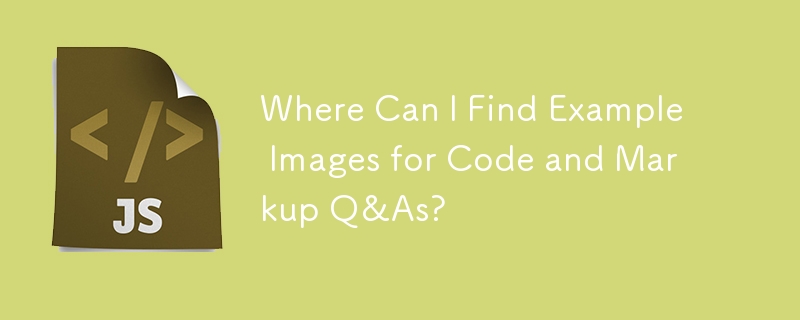
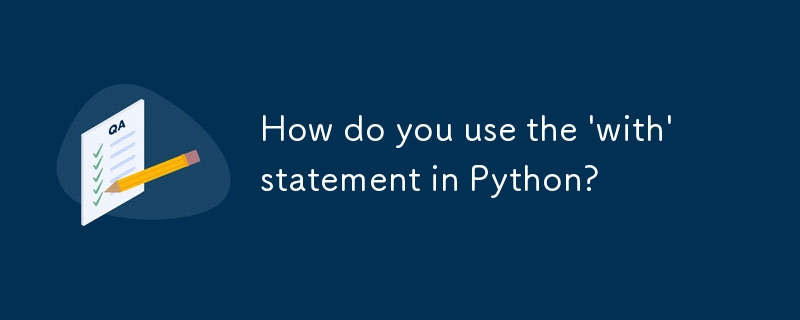
How do you use the 'with' statement in Python?
Article Introduction:The with statement solves resource management problems by automatically releasing resources. It ensures that resources such as files, network connections or locks can be properly closed even if an exception occurs after use, and avoids memory leaks or file locks that may result from manual call to close(). 1. There is no need to close manually when processing files with, and it can still be closed safely when an error occurs; 2. It can be used for any object that supports context management, such as thread locks, to ensure that the lock is released after the block is over; 3. Supports custom context managers, implemented through classes or contextlib modules; 4. It should be used when processing resources that need to be explicitly cleaned, making the code more concise, safe and easy to maintain.
2025-07-10
comment 0
692

Validating HTML Markup to Ensure Standards Compliance
Article Introduction:Verifying HTML tags is important because it improves browser compatibility, SEO optimization, and post-maintenance efficiency. Common errors include labels that are not closed, attribute values are not quoted, nested errors, etc. They can be checked and fixed through W3C online tools, editor plug-ins, CI process checking and browser developer tools. The verification goal is to ensure that the code structure is reasonable rather than pursue full marks, and partial compromises can be accepted if necessary.
2025-07-16
comment 0
585
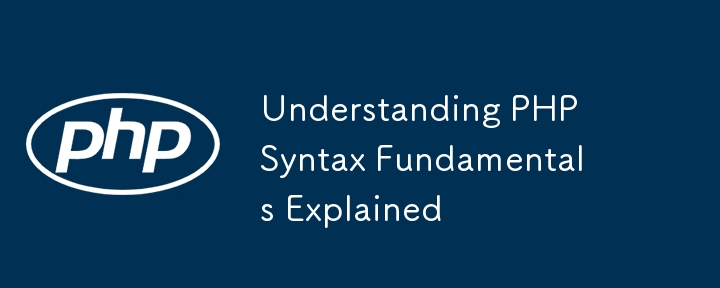
Understanding PHP Syntax Fundamentals Explained
Article Introduction:PHP is a scripting language used for back-end development. Its basic syntax includes four core parts: 1. PHP tags are used to define the code scope. The most common thing is that if all files are PHP code, closed tags can be omitted to avoid errors; 2. Variables start with $ without declaring types, support strings, integers, floating point numbers, booleans, arrays and objects, and can be cast through (int) and (string), etc. The variable scope is local by default, and global must be used to access global variables; 3. The control structure includes if/else condition judgment and foreach loops, which are used to implement program logic and repetitive task processing; 4. Functions are used to encapsulate code to improve reusability, and support parameter default values and
2025-07-18
comment 0
235

Using HTML `code` Tag for Code Snippets
Article Introduction:A tag is an inline element in HTML that marks the content of the code, semantically indicating that this is a code snippet. It does not come with its own style, and is often combined with CSS or nested in tags to enhance readability. 1. It is an inline element, and does not automatically wrap or retain indentation; 2. It is often used in combination with block-level display code; 3. It needs to be set with CSS to improve readability; 4. Compared with or, it has more semantic advantages; 5. Special characters need to be escaped, and the label needs to be closed to avoid display errors. Rational use can improve the professionalism and maintainability of the web page.
2025-07-18
comment 0
964

Visual Regression Testing for Frontend UIs
Article Introduction:The key to visual regression testing is to ensure that the appearance of the page remains unchanged after the code is updated. Its implementation can be achieved through the following points: 1. Select a tool that supports CI integration, can handle dynamic content and has clear reports; 2. Set a reasonable baseline from a small-scale core page and ignore non-critical changes; 3. Integrate the test into the PR process and the CI closed loop; 4. Set pixel thresholds to deal with false alarms, control the test environment, and pay attention to font loading issues.
2025-07-18
comment 0
466

Understanding Java Class Loader Leakage
Article Introduction:The main reasons for the Java class loader leak are that the thread context class loader is not reset, the static variable holds the class loader or class instance, the listener and callback are not logged out, and the JDBC driver registration is not cleared. 1. The thread context class loader has not been restored after use, so it should be set and restored manually; 2. Static variables hold the class loader or the classes it loads for a long time, so it cannot be recycled. It is recommended to replace strong references with weak references; 3. The listener and callback are not logged out, which will cause the class loader to be unable to be released, and it should be explicitly unregistered when closed; 4. The JDBC driver is not removed from DriverManager, which will also cause leakage, and should be actively cleaned before the application is closed. Such problems can be effectively prevented through code specifications, resource management and memory analysis tools.
2025-07-22
comment 0
450

How to Use the Java `sealed` Classes and Interfaces
Article Introduction:When using sealed classes or interfaces, the allowed subclasses must be explicitly listed through permits; 2. Each allowed subclass must be marked as final, sealed or non-sealed; 3. All subclasses must be in the same module or package as the parent class and are directly inherited; 4. It cannot be used with anonymous or local classes; 5. Combining records and pattern matching can achieve type safety and exhaustive checks. Java's sealed classes and interfaces make the type hierarchy safer and predictable by restricting inheritance relationships, and are suitable for modeling closed class variants, such as expression types or state machines. The compiler can ensure that switch expressions handle all situations, thereby improving the maintainability and correctness of the code.
2025-07-27
comment 0
768

How do context managers and the with statement simplify resource management in Python?
Article Introduction:In Python, using with statements and context managers can manage resources more securely and concisely. 1. The context manager automatically handles the setting and cleaning of resources through the __enter__() and __exit__() methods; 2. The with statement simplifies the code structure, ensuring that resources such as files, locks or connections are reliably closed after use, and will not be missed even if an exception occurs; 3. You can create a custom context manager by defining classes or using the @contextmanager decorator of the contextlib module; 4. Compared with traditional try... finally blocks, the with statement reduces redundant code, improves readability and security; 5. Common application scenarios include file operations and numbers
2025-06-18
comment 0
394

What is Continuous Integration (CI) and Continuous Deployment (CD)?
Article Introduction:Continuous Integration (CI) is the frequent merger of code and verifies quality through automated testing. Continuous Deployment (CD) is the automatic deployment of tested code to a production environment. The core of CI is "frequent merger and automated inspections". Each submission triggers an automation process, including pulling code, installing dependencies, running tests and static analysis, ensuring that problems are discovered in a timely manner. CDs are automatically launched based on CI. Common steps include building deployment packages, uploading them to the platform, and executing deployment scripts. Implementing CI/CD can be gradually expanded to the complete process by selecting the appropriate tool and simple testing.
2025-07-16
comment 0
637

HTML Standard Validation Tools and Techniques
Article Introduction:To ensure that the HTML code complies with the standards can be achieved in four ways: 1. Use online verification tools such as W3CMarkupValidationService to quickly check for errors and prompt HTTPS support; 2. Install HTML verification plug-in in the IDE to achieve real-time feedback and custom rules; 3. Use command line tools html-validate or tidy for automated batch verification and integrate with CI/CD; 4. Pay attention to hidden problems such as case mixing, label not closed, etc., and maintain good coding habits to improve compatibility and SEO performance.
2025-07-23
comment 0
541
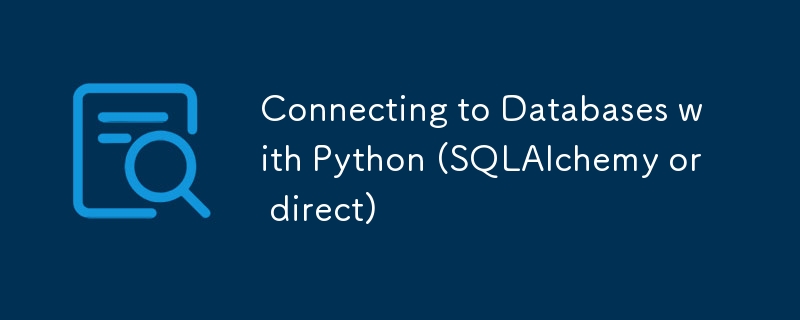
Connecting to Databases with Python (SQLAlchemy or direct)
Article Introduction:Python connection to databases can be implemented through SQLAlchemy or directly using database drivers. If you need to maintain complex queries or cross-database compatibility, it is recommended to use SQLAlchemy. Its ORM module supports object mapping and Core module provides structured queries. After installation, it is established through create_engine() and operates data with session; for small scripts or one-time tasks, you can choose to directly connect drivers such as sqlite3, psycopg2, etc., and the code is concise and efficient. In any case, the credential security should be properly managed to avoid hard-coded passwords. It is recommended to use environment variables, configuration files or key management tools, and ensure that the connection is closed in time after use to prevent resource leakage.
2025-07-07
comment 0
481
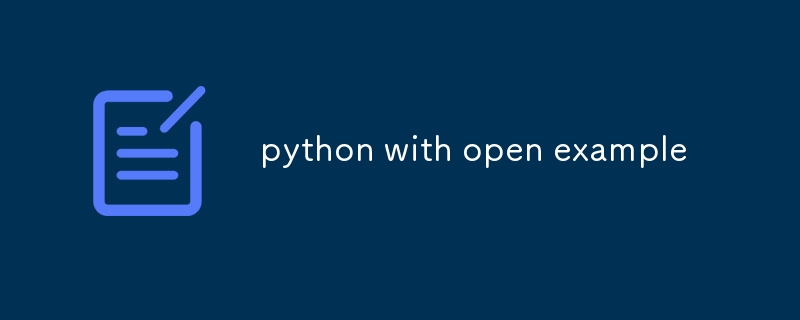
python with open example
Article Introduction:In Python, withopen() is the recommended file operation method, which can automatically manage the opening and closing of files, ensuring that the file can be closed correctly in abnormal situations. 1. Use the 'r' mode to read the file, and use the encoding='utf-8' to avoid garbled code. You can use file.read() to read all the contents, and read the file.readlines() to read it into a list by line, or process it line by line infile and remove line breaks with line.strip(); 2. Use the 'w' mode to write the file to overwrite the original content. If the file does not exist, create it and write the string through file.write(); 3. Use the 'a' mode to append the content, and add the new content to
2025-07-27
comment 0
887
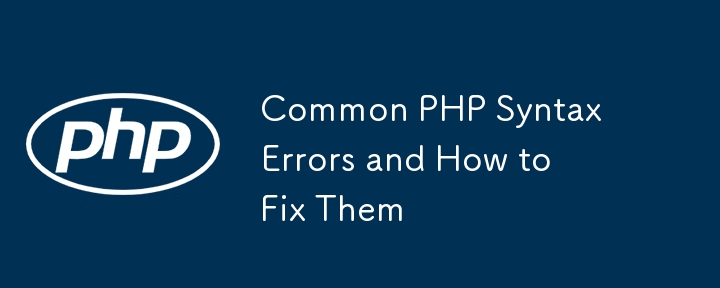
Common PHP Syntax Errors and How to Fix Them
Article Introduction:Common PHP syntax errors include missing semicolons, mismatch of brackets or quotes, variable name errors, and function call errors. 1. The lack of a semicolon will cause parsing errors and need to be added after each statement;. 2. If brackets or quotes are not closed, you can use the editor to highlight and complete them. 3. Miss spelling or inconsistent case of variable names will trigger warnings for undefined variables. Be careful to write correctly and enable error reports. 4. If the function name is misspelled or the parameter is incorrect, you need to check the function name, parameter order and extension dependencies to ensure that the function is defined or the file is included. Mastering error information, line number positioning and code tool assistance can effectively troubleshoot these problems.
2025-07-16
comment 0
166

What are HTML tags and elements?
Article Introduction:HTML tags are syntax that define the beginning and end of an element, and elements contain tags and their contents. 1. The label uses angle brackets to mark the structure of the content, such as and. 2. The element consists of the start tag, the content and the end tag, such as Thisisaparagraph. 3. Self-closed labels such as and do not wrap content, no end label is required. 4. Elements can be nested with other elements to form a web page structure. 5. Common errors include unclosed tags, wrong tag names and improper tag nesting. Understanding the difference between the two helps to write and debug HTML code correctly.
2025-07-21
comment 0
932

How does Go manage memory allocation and deallocation for slices and maps?
Article Introduction:Go automatically manages memory allocation and release of slices and maps, but understanding its underlying mechanisms helps write more efficient code. 1. Slices are built on arrays, including pointers, lengths and capacity to the underlying array; when the slice exceeds the capacity, a new larger array will be allocated and the data will be copied, and the old array can be recycled after no references; frequent appending or sliced ??from large arrays in a loop may affect performance, and the required data should be pre-allocated or explicitly copied. 2. The mapping is implemented in a hash table, and several buckets are initially allocated to store key-value pairs. When inserting more, the bucket is expanded; the delete key will not release the memory immediately, but will be reserved for subsequent insertion; manually clearing all keys is not as effective as recreating the map, and its memory behavior is difficult to accurately control. 3. Go's garbage collector will recycle data that is no longer referenced
2025-06-17
comment 0
806

What is the SOLID design principles, and how do they apply to Python development?
Article Introduction:The SOLID principle is five design principles used in object-oriented programming to improve the readability, flexibility and maintainability of software design, and is also applicable in Python development. 1. The single responsibility principle (SRP) requires a class to do only one thing, avoid putting irrelevant functions in the same class, which can be implemented by splitting logic or using auxiliary modules; 2. The open and closed principle (OCP) emphasizes opening up for extensions, closing down for modifications, and extending functions through inheritance or combination without changing existing code; 3. The Richter replacement principle (LSP) ensures that subclasses can replace parent classes without destroying program behavior, and keep the method contract consistent, avoiding the introduction of exceptions or different return types during rewriting; 4. The interface isolation principle (ISP) advocates defining fine-grained interfaces so that clients only
2025-06-25
comment 0
944

Mastering Go Channels for Complex Architectures
Article Introduction:The following points should be paid attention to when using Go's channel efficiently in complex architectures: 1. Select a buffered or unbuffered channel according to the scenario. The former is suitable for decoupling producers and consumers, and the latter is used for strict synchronization; 2. Use context to control the goroutine life cycle to avoid leakage, and ensure that the channel is closed when exiting; 3. Use channel to achieve task scheduling and load balancing, such as fan-in/fan-out mode to improve concurrent processing capabilities; 4. Use select, range and correctly close the channel mechanism to enhance code robustness. Mastering these techniques can effectively improve the maintainability and performance of programs and avoid deadlocks and resource leakage problems.
2025-07-16
comment 0
468

How to fix 'The requested resource is in use'
Article Introduction:When encountering the "Therequestedresourceisinuse" error, it is usually because the target resource is being occupied by other programs. The solutions include: 1. Close the program that occupies the file, and you can manually check or end the process through the task manager; 2. Release the occupied port, use the command line tool to find and terminate the corresponding process; 3. Check whether there are unreleased resources in the code, such as file, database connection, etc., to ensure that the automatic release mechanism is correctly closed or used; 4. If it still cannot be solved, you can try to restart the device or related services to clean up the resource status. The key to avoiding such problems is to release resources in a timely manner and avoid multiple programs operating the same content at the same time.
2025-07-22
comment 0
381



















